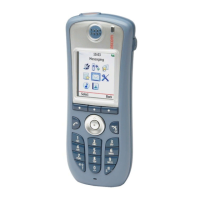TD 92685EN
28 June 2012 / Ver. A
Troubleshooting Guide
Ascom i62 VoWiFi Handset
27
3. The VoWiFi Handset as
stream may be passing through the SIP proxy or may be routed directly between the VoWiFi
Handsets when using a controller with thin APs.
3.8.5 Message Content
Requests and responses may contain a message header and mes
sage body that the support
engineer can inspect using a protocol analyzer tool such as Wireshark. Traces of message
headers and responses can provide valuable troubleshooting information.
An INVITE message, for example, would generate a message header with t
he following kind
of content:
Field Description
Via Indicates the path taken by the request so far. Th
e main purpose of the Via
header is to ensure that responses take the same path as the requests so
that resp
onses can be routed back to the call initiator.
A Via field value is add
ed after the transport that will be used to reach the
next hop has been selected. The entity that generates the header inserts its
address in the Via field and all subsequent proxies that fall in the path also
insert their own address as Via fields.
A response that replies to a request keeps all the Vi
a values in same order as
they are received. Proxies that fall in the reply path then remove their own
Via address and forward the response back. Hence, when the response
reaches the call initiator it contains only the Via address of the call initiator.
The call initiator strips off this Via value and finding that there are no more
Via’s left, processes the response.
All requests must include a Via fi
eld. The protocol name and protocol version
in the header must be SIP and 2.0, respectively. The field must also include a
branch parameter. This parameter is used to identify the transaction created
by the request. This parameter is used by both the client and the server
Example 1: SIP
/2.0/TCP servera.com:5060;branch=z9hG4bK74bf9
Example 2: (OK
Response)
Via: SIP/2.0/TCP servera.com;branch=z9hG4bK721; received=192.0.2.222
Via: SIP/2.0/TCP serverb.com;branch=z9hG4bK2d4;received=192.0.2.111
Via: SIP/2.0/TCP serverc.com;branch=z9hG4bK74b;received=192.0.2.101
From The address of logical identity of the requ
est initiator, possibly the user's
address-of-record. The field contains a URI and optionally a display name. It is
used by SIP elements to determine which processing rules to apply to a
request.
Note: The field must conta
in a new tag parameter, chosen by the call
initiator.
Example: "Fre
ddy" <sips:freddy@serverb.com>;tag=a48s
To The address of the intended recipient of the
request or the AOR of the user or
resource that is the target of this request.
Note: Th
e field must contain a new tag parameter, chosen by the recipient.
Note: Th
e field always contains a tag once the dialog is established.
Example: “Charl
ie”<sip:user2@serverb.com>;tag=6t3r
Call-ID A unique identifier to group together a series of m
essages. It must be the
same for all requests and responses sent by the calling and called parties
within a dialog.
Example: 123456@servera.
com

